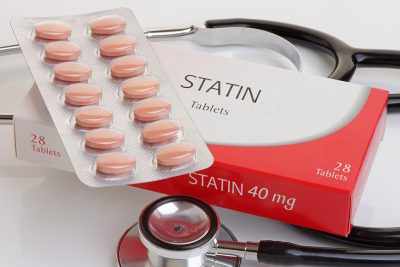
Statins for Abdominal Aortic Aneurysms
October 1, 2025
By Michael H. Crawford, MD, Editor
Synopsis: An analysis of two large, abdominal aortic aneurysm (AAA) screening populations from Denmark has shown that high-dose statin therapy reduces the rate of AAA growth, the need for repair, and adverse outcomes, such as rupture and death.
Source: Skovbo JS, Obel LM, Diederichsen ACP, et al. Association of statin treatment and dose with the clinical course of small abdominal aortic aneurysms in men: A 5-year prospective cohort study from 2 population-based screening trials. Circulation. 2025;152(6):384-396.
Recent observational studies have suggested that statins may decrease the progression of abdominal aortic aneurysms (AAA) and reduce the risk of rupture. These investigators from Denmark noted that the growth rate of AAA were 50% less in the 2014-2018 Danish Cardiovascular Screening trial (DANCAVAS) than in the 2008-2011 Viborg Vascular trial (VIVA). The most notable difference between the two trials was the intensity of statin therapy. Thus, they combined the subjects in these two AAA screening studies to evaluate the effect and dose dependency of statin use across the combined cohorts.
The primary outcome was the rate of AAA growth, and the secondary outcome was the composite of AAA need for repair, rupture, and all-cause mortality. AAA was defined as an abdominal aorta diameter from 30 mm to 55 mm. Subjects with abdominal aorta diameters > 55 mm were excluded, since this is a guideline indication for surgical repair. VIVA included 50,156 men between 65 and 74 years of age. Ultrasound was used to measure the aortic diameter. DANCAVAS included 46,611 men in the same age range. Computed tomography (CT) was used to measure aortic diameter. From the two studies, a total of 998 men met the inclusion criteria, with median age of 70 years and with a baseline average aortic aneurysm diameter of 35 mm. Statin use was calibrated using the World Health Organization Center for Drug Statistics Methodology defined daily dose (DDD), which is based on the typical dose of each drug for the specific indication. Non-statin users were DDD-0 (11%), low-intensity dose users were DDD-1 (24%), middle-intensity dose users were DDD-1-2 (48%), and high-intensity dose users were DDD > 2 (17%).
The DDD > 2 group at baseline had more comorbidities and were taking more medications. The subjects were followed for five years. The Danish national medical registries were used to extract clinical data and mortality. Consecutive imaging of the aortic aneurysm was performed in 83% of the subjects and growth rates in aortic aneurysm diameter were 2.2 mm/year in the non-users, 2.4 mm/year in the low-intensity statin group, 2.3 mm/year in the middle-intensity group, and 1.5 mm/year in the high-intensity group (high- vs. low-intensity group difference, P = 0.001).
Statin use was significantly associated with a decreased AAA growth rate; an increase of one DDD of statin per day was associated with an adjusted change in growth rate of -0.22 mm/year (95% confidence interval [CI], 0.39-0.06; P = 0.009). The five-year incidence of AAA repair per doubling of statin dose resulted in a reduced adjusted hazard ratio (HR) of 0.82 (95% CI, 0.70-0.97; P = 0.023) and statin use significantly lowered the risk of the composite outcome of repair, rupture, or mortality (adjusted HR, 0.83; 95% CI, 0.73-0.94; P = 0.003). The authors concluded that AAA patients could benefit from high-dose statin therapy beyond targeting their associated risk factors.
Commentary
Observational studies have suggested that statins and metformin may reduce AAA growth and reduce the risk of rupture. There currently are four randomized trials of metformin underway, but no trials of statins have been initiated. Thus, this large, prospective, observational study from Denmark is of interest.
In the United States, Medicare will cover the expense of AAA screening for those with a family history of AAA or men aged 65-75 years who have ever smoked. Given the age range of the almost 97,000 men selected for these Danish AAA screening studies (65-74 years), it is not surprising that 1% had aortic aneurysm diameters in the 30 mm to 55 mm range. It is highly unlikely that these results were the result of chance, since only the high-intensity statin therapy group benefited, and the results were consistent in sensitivity analyses. Presumably, the mechanism of this beneficial effect is the anti-inflammatory properties of statins, which reduce atherosclerotic aortic disease.
There are limitations to this study to be considered. Each of the studies used different imaging techniques: ultrasound (VIVA) and CT (DANCAVAS). Also, VIVA studied simvastatin 40 mg/day and DANCAVAS studied atorvastatin 40 mg/day. These differences could have affected the results. In addition, over the time course of these two studies, endovascular repair became more prevalent. However, this would bias the study toward more surgical intervention in the statin-exposed group, which would work against the observed protective effects of statins.
These studies only included white men 60-74 years of age and would not necessarily be applicable to other groups and to women. Interestingly, there is a custom in Denmark to stop statins in patients with a limited life expectancy, which could introduce a healthy user bias and would inflate the benefit of statins. Finally, this is an observational study in which residual confounding cannot be totally excluded.
Current guidelines recommend statin use in AAA patients because of their increased risk of atherosclerotic cardiovascular disease. At a minimum, this study reinforces this recommendation.
Michael H. Crawford, MD, is Professor Emeritus of Medicine and Consulting Cardiologist, UCSF Health, San Francisco.